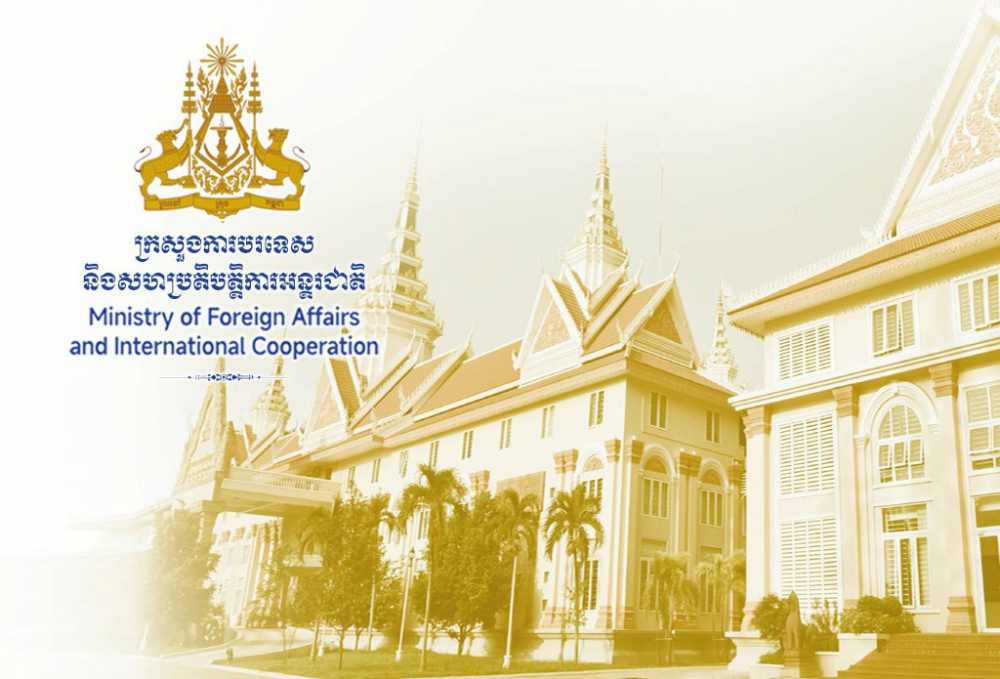Phnom Penh, July 5 (AseanAll) — On July 5, 2025, Cambodian Foreign Affairs and International Cooperation Ministry issued a statement addressing recent developments and reaffirming Cambodia's principled position regarding the ongoing border issues with Thailand.

The following is the full text of the statement translation:
1. On 28 May 2025, at approximately 5:30 a.m., Thai armed forces unlawfully entered Cambodian territory and opened fire on a Cambodian military post in Techo Morokot Village, Morokot Commune, Cham Khsan District, Preah Vihear Province. This unprovoked act resulted in the tragic loss of a Cambodian soldier’s life. The following day, the Royal Government of Cambodia issued an official protest, firmly condemning this grave violation of Cambodia’s sovereignty and territorial integrity, an act in clear contravention of the United Nations Charter, the ASEAN Charter, and the core principles of international law. Cambodia has called for an independent and impartial investigation into the incident and demands accountability and justice for its fallen soldier.
2. In the face of this unjustified use of force, Cambodia has exercised utmost restraint and has taken responsible measures to de-escalate tensions, including sustained communication and engagement at various levels of government and military. Regrettably, the situation has deteriorated further, with increased military deployments on the Thai side prompting necessary defensive measures by Cambodia to prevent further encroachments. Unilateral actions by Thailand – including the closure of border checkpoints without prior consultation, the digging of trenches in sensitive areas, and threats to disrupt essential services, such as cutting internet connection, electricity and oil supply – have significantly heightened tensions. Compounding these challenges is the prolonged paralysis of the Joint Commission on Demarcation of Land Boundary (JBC) due to the absence of response from the Thai side to Cambodia’s repeated invitations for dialogue, Thailand’s insistence on using a unilaterally drawn map contrarily to the letter and spirit of the Memorandum of Understanding on the Survey and Demarcation of Land Boundary, signed in 2000 (MOU-2000) which clearly provides for the use of maps produced by the Commission of Delimitation of the Boundary between Indo-China and Siam for border demarcation between the two countries, and recent statements by the Thai military alluding to the use of force to solve disputed areas claims. Furthermore, the current tension over several areas along the border could become a repetition of what happened between 2008-2011 and earlier. These circumstances have led Cambodia to conclude that the bilateral mechanism is no longer viable for resolving certain longstanding disputes.
3. In light of the seriousness of the situation and driven by our steadfast commitment to preventing any escalation into open conflict that would endanger civilian lives, Cambodia has decided to refer the dispute over four long-unresolved areas – namely Tamone Thom Temple, Tamone Touch Temple, Ta Krabey Temple, and the Mom Bei area – to the International Court of Justice (ICJ). Cambodia firmly believes that recourse to this impartial legal mechanism is the most effective and peaceful path toward a just and lasting resolution.
4. On 6 June 2025, the Cambodian Minister of Foreign Affairs and International Cooperation formally extended an invitation to his Thai counterpart to jointly submit the case to the ICJ. This invitation was reiterated during the Cambodian-Thai JBC meeting held in Phnom Penh from 14 to 15 June 2025. To date, no official response has been received from the Thai side.
5. Cambodia’s decision to refer the dispute to the ICJ is fully consistent with the UN Charter and international law. It is grounded in a solid legal foundation: the areas in question lie entirely within Cambodian territory as defined by the Franco-Siamese Convention of 1904 and Treaty of 1907, and as reflected in the maps prepared by the Franco-Siamese Mixed Commission. These maps, jointly acknowledged and endorsed by both countries, were reaffirmed in the MOU-2000 as the basis for border demarcation.
6. Cambodia’s recourse to the ICJ, the principal judicial organ of the United Nations, should not be misconstrued as a hostile or provocative act. Rather, it is a peaceful, responsible, and lawful measure that reflects Cambodia’s unwavering commitment to international law and the rules-based international order. Other ASEAN members, including Malaysia and Indonesia (2002), and Malaysia and Singapore (2008), have likewise turned to the ICJ to resolve territorial disputes with success and mutual respect. Cambodia remains open to the existing bilateral mechanisms for resolving the remaining sections of the border in accordance of international law, with the exception of the four disputed areas.
7. Cambodia once again urges the Kingdom of Thailand to demonstrate good faith by accepting the jurisdiction of the ICJ in this matter. Such a step would uphold its international obligations under the UN Charter and reflect a sincere commitment to achieving a just, fair, and peaceful resolution—one that would contribute to long-term peace and stability for both nations and the region at large.
8. Cambodia reaffirms its unwavering commitment to the peaceful settlement of disputes based on international law and the principles enshrined in the UN Charter. Cambodia aspires to transform the shared border into a zone of peace, stability, cooperation, and development for the mutual benefit of both peoples. At the same time, Cambodia will resolutely safeguard its sovereignty and territorial integrity – rights guaranteed to all sovereign states under international law – and expects its neighbour to act in the same spirit of mutual respect and peaceful coexistence.
July 4, 2025